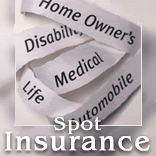LOS ANGELES--April 13, 2005--Consumers are countering rising gasoline prices and other vehicle operating costs by capitalizing on lower auto insurance rates, according to Answer Financial Inc., the nation's leading independent insurance agency. With more than 100,000 in-force policies across all 50 states, the Los Angeles-based company has observed an increase in consumers shopping online for policies and pricing across its own and its competitors' rate cards. Answer Financial's "Top 10 Rate-Saver Checklist" reveals several points often overlooked by individuals and families in shopping for lower cost and better quality auto policies.
"In the face of soaring gas prices, consumers may feel powerless, but they can lessen the pain by shopping for better priced insurance, which remains a large expense of vehicle ownership," says Alan Snyder, CEO and founder of Answer Financial Inc. "Shopping for car insurance slashes costs. Drivers generally are unaware of the myriad factors that determine rates, particularly with auto policies. In today's market, thanks to the Internet and to competition, it's easier than ever to get more value at a lower cost."
Auto policy costs and regulations vary significantly from state to state, but there are a number of areas that consumers are able to control and adjust to optimize prices and quality, Snyder notes.
Answer Financial's Top 10 Rate-Saver Checklist
1. Check Credit Rating - In all states except California, an
individual's credit rating is a key factor that affects auto
insurances rates. Good credit will be interpreted by insurers as
less risky. Thus, it's important for consumers to order copies of
their credit report from all major credit agencies to ensure
accuracy and to correct any inaccurate derogatory points, such as
late or missed payments, maxed-out credit lines, bankruptcy,
foreclosure, etc.
2. Check Motor Vehicle Report - Like credit reports, state driving
records may include inaccurate data on personal driving records,
which are strongly considered when issuing respective individual
and family auto rates. In addition, tickets, traffic school
credit, and accident fault are sometimes not accurately reflected
in state data, costing consumers hundreds or even thousands of
dollars. Drivers should report errors to both their state motor
vehicle department as well as their insurance carrier.
3. Double Check Accident Reports - Local law enforcement and
insurance accident reports occasionally include mistakes that will
result in a higher rate. Accident reports are separate from motor
vehicle records. Accident reports affect insurers' decisions and
rates on a cumulative basis particularly if the driver has tickets
or accidents down the road.
4. Never Let Coverage Lapse and Review Deductibles - Maintaining
coverage without lapse makes a significant difference in rates.
Separately, while deductible amounts initially save drivers in the
event of a quick claim, they cost consumers more in the long run
due to higher premiums. Drivers almost always save on premiums
with higher deductibles of $500 or $1,000.
5. Look for Package Rates - In addition to multiple-vehicle
discounts, consumers often save substantially by packaging all
their insurance policies including auto, home, and personal
liability together with one company.
6. Don't Miss Good Student and Mature Driver Discounts - Most
consumers know that safe drivers are rewarded by insurers, but
it's important to make sure your policy gives you a good driver
discount. Most insurers lower rates for mature drivers (55 years
and over) and for students who carry a 3.0 grade point average or
better. Some carriers give more credit for these points than
others, so shop around.
7. Take a Driving Safety Course - Many insurers will cut rates for
drivers who take an approved driving safety course. Make sure that
you've registered for a course recognized by your carrier, which
will not only cut your rates but likely save in ticket fines and
reduce your risk of bodily injury on the road.
8. Don't Forget Car Pool Credit - Many auto carriers drop premiums if
you car pool to the office, especially if you drive more than 10
miles roundtrip. In addition, you'll save considerably on the
rising prices at the pump and lend a hand to Mother Nature.
9. Check Rates Before Buying a New Car - Insurance rates vary
considerably from car to car. Often expensive vehicles can add
$50 - $100 per month in premiums. The type of vehicle, engine size
(you'll pay for that turbo), parts costs and safety tests are all
factored into insurance premiums. Sport cars and SUVs generally
are more expensive to insure. Buyers often do not realize the big
rate differences until after they drive off the lot.
10. Take Credit for Safety/Security Features - Drivers should make
sure they are receiving lower rates for safety features such as
air bags and anti-lock brakes. Devices that deter theft, such as
alarm systems or devices that disable or track vehicles (such as
LoJack), may also qualify for discounts. Some companies even waive
deductibles if the car has been damaged when it was stolen but is
recovered using a tracking device.
Auto Insurance; Top 10 Checklist Uncovers Hidden Savers
Subscribe to:
Post Comments (Atom)
Search
Categories
- Assurance (2)
- Auto (16)
- Auto Insurance (9)
- Auto Insurance Companies (5)
- Auto Insurance Quotes (4)
- Automobile Insurance (2)
- bush (1)
- Business Insurance (2)
- Car Insurance Quotes (2)
- Cheap Auto Insurance (1)
- COBRA Insurance (1)
- cover (1)
- Flood Insurance (2)
- General Loan Information (1)
- george (1)
- george bush (1)
- Guides And Tips (18)
- Health Insurance (6)
- Health Insurance Quotes (1)
- Homeowner Insurance (1)
- insurance (15)
- Insurance Informations (1)
- insurance news (9)
- Insurance Provider (1)
- Insurance Rates (1)
- Insurance Tips (7)
- lemon law (3)
- life insurance (1)
- Life Insurance Quotes (1)
- Medical Insurance (2)
- money (1)
- Mortgage Insurance (1)
- online (1)
- Online Insurance (1)
- points (1)
- safety (2)
- Sedan (1)
- steps (1)
- Travel Insurance (2)
- Vehicle (2)
- vehicle cover (1)
- vehicle cover premiums (1)
- Whole Life Insurance (1)





0 comments:
Post a Comment